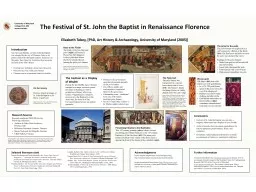

San Giovanni Battista or Saint John the Baptist was adopted by the city of Florence Italy as its patron saint in the thirteenth century Each year on the saints day June 24 festivities amp processions are held in ID: 286156
Download Presentation The PPT/PDF document "Introduction" is the property of its rightful owner. Permission is granted to download and print the materials on this web site for personal, non-commercial use only, and to display it on your personal computer provided you do not modify the materials and that you retain all copyright notices contained in the materials. By downloading content from our website, you accept the terms of this agreement.
Slide1
Introduction
San Giovanni Battista, or Saint John the Baptist, was adopted by the city of Florence, Italy as its patron saint in the thirteenth century. Each year on the saint’s day (June 24), festivities & processions are held in St. John’s honor.Festival once included horse race ( palio)Prize for race was a silk palio bannerFlorence is a renowned center for textiles
Research SourcesResearch conducted in 2002-2004 in the following collections:Archivio di Stato (State Archives), Florence, ItalyBiblioteca Nazionale Centrale, FlorenceMuseo Nazionale del Bargello, FlorenceUffizi Gallery, Florence
AcknowledgmentsPoster template adapted from Colin Purrington blog, http://colinpurrington.com/tips/academic/posterdesign.Images downloaded from ArtStor (http://library.artstor.org/) through the University of Maryland Libraries’ Research Port unless otherwise noted.
The Festival as a Display of WealthDuring the late Middle Ages, Florence emerged as a major economic power in Europe in banking as well as production of luxury silk woven textiles. Originating as a religious procession to the Baptistery on the saint’s day, the festival of St. John the Baptist became an opulent annual spectacle in which the whole city participated. City of Florence spent lavish amounts annually on the palio bannerOfficials, guilds, and confraternities constructed floats for the processionCulminating event—traditional horse race with winner receiving palioIn 1563, Grand Duke Cosimo I de’ Medici added a Roman-style chariot race in Piazza Santa Maria Novella
ConclusionsFestival of St. John the Baptist was not only a religious observance but a display of civic wealthHigh expenditures recorded for festival art (palio banners, floats, and costumes)Italian society valued festival art as much as painting, sculpture, architecture
Elizabeth Tobey, [PhD, Art History & Archaeology, University of Maryland (2005)]
Selected literature citedTamara Boccherini and Paola Marabelli, eds. Sopra Ogni Sorta di Drapperia…” Tipologie decorative e techniche tessili nella produzione fiorentina del Cinquecento e Seicento. Florence: Maria Cristina de Montemayor Editore, 1993.Chretien, Heidi L. The Festival of San Giovanni: Imagery and Political Power in Renaissance Florence. American University Studies IX. Vol. 138. New York: Peter Lang, 1994.Landini, Roberta Orsi. Velluti e Moda tra XV e XVII secolo, Museo Poldi Pezzoli. Milan: Skira Editore, 1999.Pastori, Paolo, ed. La festa di San Giovanni nella storia di Firenze. Rito, istituzione e spettacolo. Florence: Edizioni Polistampa, 1997.Stanley, Tim. Palace and Mosque: Islamic Art from the Victoria and Albert Museum. Washington: National Gallery of Art, 2004.Trexler, Richard. Public Life in Renaissance Florence. 1980; Ithaca, NY: Cornell Paperbacks, 1996.
Further informationCreated by Elizabeth Tobey (etobey@verizon.net) in January 2015 as an example of poster design for the Maryland Center for Undergraduate Research (MCUR) at the University of Maryland (www.ugresearch.umd.edu). The content is based upon Tobey’s doctoral dissertation, “The Palio in Italian Renaissance Art, Thought, and Culture” (University of Maryland, 2005).
The Festival of St. John the Baptist in Renaissance Florence
On
the moneySt. John the Baptist, a Christian saint, was celebrated by Florence from the 13th c. onwards during a period of economic growth and prosperity. St. John appeared on the city’s currency, the florin, or gold coin.
Presenting tributes to the Baptistery
This 15
th
-century painting (above) shows citizens presenting palii (tribute banners) to the 11th-century Baptistery of San Giovanni (far left). The main palio banner (awarded to the winner of the horse race) is depicted in front of the façade of the duomo (cathedral of Santa Maria del Fiore) (left).
The
palio
bannerThe palio banner was displayed on a cart bearing city officials at the finish (left). The first horse and rider to reach the palio was declared the victor.Made from gold or red brocade silk and velvet fabricLined with a thousand fur peltsEmbroideredExpensive to produce
Race to the Finish
The finish of the St. John palio race (right) in Florence’s Piazza San Pier Maggiore. Jockeys pilot their horses (barberi) towards the cart bearing the prize palio banner.Image and detail on right: Giovanni Toscani, Palio in Florence, 1418, tempera and panel on wood, Cleveland Museum of Art, ArtStor.
The Palio CartThe palio banner was transported on a special horse-drawn cart or carro (left). The banner’s luxury fur lining (fodera) is visible draped across the cart’s edge.Image on left: Cart of the Palio of St. John the Baptist, fol. 39r in L. Chiari, Priorista, c. 1630-1640, Biblioteca Nazionale, Florence (reproduced in Pastori, La festa di San Giovanni, 122, fig. 28.
Woven gold
Silk fabric (
left
) was often interwoven with gold thread.In 1478, 220 gold florins spent on the palio (twice the cost of an altarpiece!)Banners recycled to make clothing and altar clothsGold thread embroidery on luxury fabrics (right) sometimes commissioned from nuns at area conventsImages (left & right): Silk velvet, Italian, 15th c., Victoria & Albert Museum, London, from Stanley, Palace and Mosque, 124. Paliotto (Altarcloth), Venetian, 15th c., Museo Poldi Pezzoli, Milan, from Landini, Velluti e Moda tra XV e XVII secolo, 51-52.
Images
(left to right): "Baptistery (San Giovanni), exterior, with the Campanile (Giotto's Tower) at right," Florence, ArtStor; Detail and full image of Rossello di J. Franchi’s Festa di S. Giovanni (Feast of St. John), 1430, tempera on panel, Museo nazionale del Bargello, Florence, ArtStor; (Detail photographed by Elizabeth Tobey with permission of museum).
University of Maryland
College Park, MDwww.umd.edu
Image
: Florin
Coin with image of St. John the Baptist,
15th c., gold,
Museo
nazionale
del Bargello (Florence, Italy),
ArtStor
.